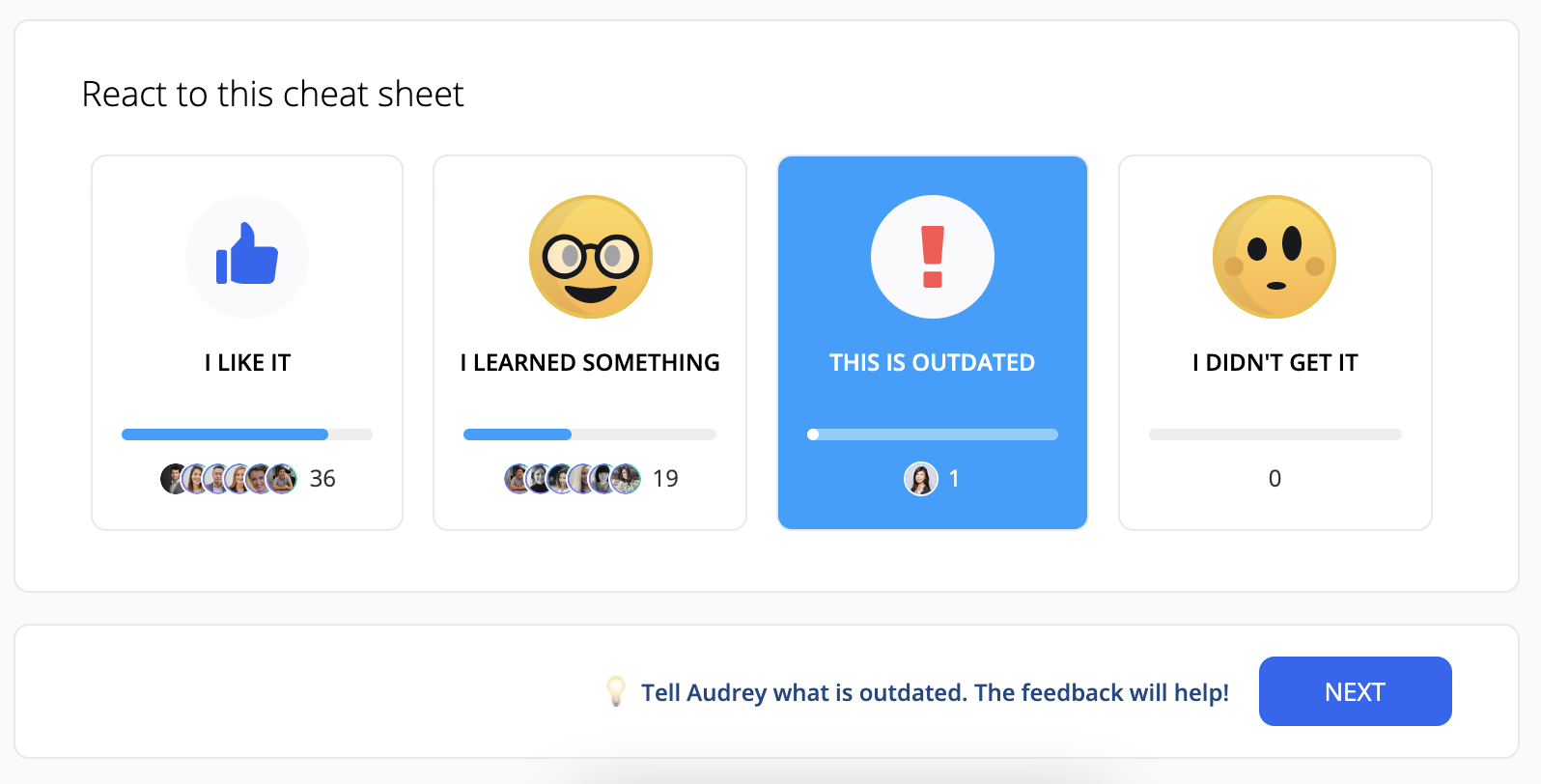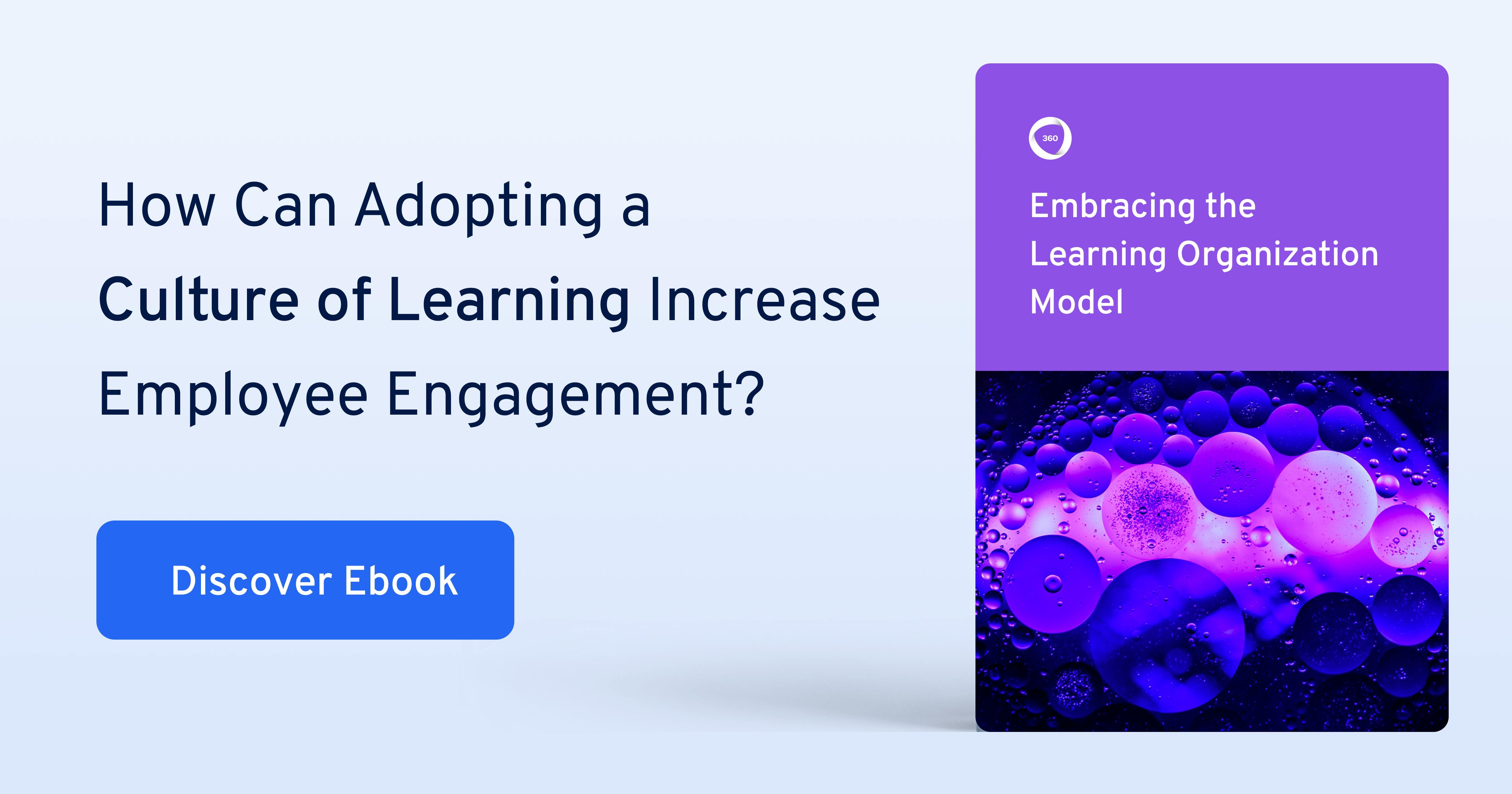If you want to survive, you have to prepare to adapt. In areas known for flooding, people put houses on stilts. In arid climates, roofs are coated with reflective material to stave off the heat. And in the business world, where change often comes quickly and drastically—like a pandemic closing offices—many companies survive by rapidly rolling out training and providing the tools required to help their team adapt to a new environment.
Knowledge and learning are pivotal to adaptation. When one can quickly learn from a situation and inform others, the entire group can adapt as necessary. Companies that make continuous learning a strategic priority—in other words, Learning Organizations—are better equipped to handle unforeseen turbulent times.
Below, we’ll explain how Learning Organizations allow you to quickly learn from mistakes, build a more engaged workforce, and adapt on the fly. Plus, we’ll outline how you can combine your existing assets—your people—with new tools and processes to become a Learning Organization designed to survive.
What is a Learning Organization?
A Learning Organization makes learning a part of day-to-day work by building out the right processes and giving employees the tools necessary for teaching and learning from others, rather than putting all of the burden on L&D. In a Learning Organization, knowledge is shared, mistakes are learning opportunities, and traditional learning is sidelined for a more flat or democratic structure that favors a true learning culture throughout. But this is only scratching the surface.
A Learning Organization thrives on knowledge sharing. It uses Collaborative Learning tools and processes to ensure every employee is able to share their knowledge while learning from others. A collaborative learning management system (LMS) is used to make knowledge available to all.
Learning Organizations are also similar to flat or democratic organizations. There are no “teachers” or “students.” Instead, everyone’s encouraged to teach others while equally encouraged to learn at every available opportunity. This includes learning from mistakes, both personal and company-wide.
Related: Why You Can't Afford to Ignore Organizational Learning
The characteristics of a Learning Organization
All Learning Organizations will have unique features and processes that set them apart. Still, there are five pillars that act as the foundation for every Learning Organization:
- Systematic problem-solving: A Learning Organization learns and creates at every available opportunity and then scales these efforts throughout the entire company.
- Experimentation: A Learning Organization regularly performs experiments to find opportunities for growth and learning as soon as possible. Learning Organizations also leverage real-life situations to find ways to improve processes and the business as a whole.
- Transferring knowledge: The traditional hierarchical structure is ditched for a flat approach in Learning Organizations, meaning anyone can teach, everyone can learn, and knowledge is free of silos. Above all else, knowledge is to be shared as quickly as possible with everyone who wants it.
- Learning from others: A Learning Organization depends on internal experts to act as vehicles for knowledge, creating courses or spearheading mentorship sessions and ensuring everyone gets the chance to learn from others.
- Learning from past experiences: Continuous improvement is a core piece of the Learning Organization model. Mistakes and past experiences are never wasted and should be turned into teaching moments for the company as a whole.
The above characteristics aim to give shape to the aspiration that people should always be learning. They put your organization on the hook to ensure you're offering the best opportunities to learn and not just paying lip service to the idea. In the words of Matthew Smith, Chief Learning Officer at McKinsey & Company, “If you’re going to tell people that they have to be lifelong learners, you’ve got to arm them with the skills and the opportunities that are going to enable them.” (Hint: You'll find a roadmap for doing so in the ebook below).
The Benefits of a Learning Organization
There are a number of reasons to move to the Learning Organization model, whether you’re one of the many companies forced to go remote as the result of a pandemic or Disneyland looking to keep employees happy and engaged in a new environment.
Learning Organizations maintain institutional knowledge
Institutional knowledge is proprietary information within your company—how to do a specific task or ways to communicate with your clients, etc. Without any kind of institutional knowledge retention in place, this knowledge walks out your door when someone leaves the company.
The Learning Organization model involves capturing information from all experts. If someone is an expert on doing a particular task, a Learning Organization ensures that person’s knowledge is in a course or company wiki. In other words, the person can leave your company, but their knowledge stays forever.
Learning Organizations make learning more convenient
In a traditional learning model, learning happens at a pre-determined time—quarterly training or mandatory meetings. This translates to disruptions for your team, as a blanket time will rarely fit everyone’s schedule. (Read: It will never fit everyone’s schedule. And even if everyone does show up, chances are someone’s scrolling through Twitter or doing work on the side).
In a Learning Organization, learning opportunities are present via mentorships or buddy programs, self-directed online courses, and in company wikis. This means learning takes place at the point of need or when the employee actually needs the information. This also means the learning takes place when the employee actually has time.
The accessibility and convenience of learning in the Learning Organization model are crucial, as a majority of employees cite a lack of time as their reason for not learning more at work. When you put employees in control of finding time to chat with a mentor or take a self-guided course, you’re allowing learning to adapt to their schedule, not the other way around.
Related: Pivoting to Agile Learning Could Revolutionize Your Learning Culture
If you’re going to tell people that they have to be lifelong learners, you’ve got to arm them with the skills and the opportunities that are going to enable them.
Learning Organizations provide clear paths for growth
As a Learning Organization, learning is a core part of your company and team growth. A Learning Organization will work with employees to set concrete goals around learning and create paths for professional growth.
If someone makes it their goal to learn tools relevant to another role and completes their goals, that employee is a prime candidate for promotion into that role. Celebrate these moments to let employees know—learning is important, goals tied to learning are important, and growth will happen as a result of both.
These same paths of growth can be used to help your team adapt to change. If your industry’s in a state of flux and your model needs to shift, that same growth-oriented path can be used to guide your team in a new direction through learning.
How to become a Learning Organization
Virtually any company can become a Learning Organization, but it won’t happen overnight. Becoming a Learning Organization requires breaking open your L&D structure, leveraging experts, and providing the tools and opportunities for learning to take place.
Identify and leverage internal experts early on
The first step toward becoming a Learning Organization is to turn to your internal experts. This process is a must, as it allows you to get allies early on who can help you speed up the Learning Organization transformation process.
- Go through your teams and identify experts in certain areas. Ask those experts if they’re willing to help out with identifying knowledge gaps or training needs for new hires in their departments, and so on. If you have a large team with hundreds of people or more, turn to team leads and have them identify the experts within their departments.
- Send out a quick survey to see what knowledge gaps your experts and anyone willing to participate notice. This will make it easier for your experts to identify which areas need to be covered via courses or wiki content ASAP.
So, if you’re building out a new onboarding process for the marketing department, ask senior marketing team members to help with identifying areas of improvement they’ve noticed for newer employees. New employees can be experts here as well, helping you identify pain points they experienced upon joining or areas where training fell short.
Create opportunities for active learning
Take all that expert knowledge you gathered in the previous step and put it to work by creating courses and wikis that engage and serve your learners. Even better, have the experts from the previous step create the courses themselves. A Collaborative Learning platform will facilitate this by allowing your experts to quickly create courses and even collaborate on them together.
Build interactive courses: Create interactive courses when appropriate, rather than traditional presentations. Interactive courses allow your team to answer questions via a digital quiz, work their way through scenarios, and engage with the information in a way passive learning doesn’t allow. Active learning also helps learners retain more information than its passive learning cousin.
Foster Collaborative Learning: Beyond interactive courses, you should also create active learning situations that utilize Collaborative Learning. Mentorships or onboarding buddy programs are a straightforward way to get two or more employees engaged in knowledge swapping, with the added benefit of helping your team get to know one another.
Open modes of communication, like transparent Slack threads or Trello comments, as opposed to private messages, also allow for social and active learning. When someone’s hashing out a work problem in a public thread, anyone is free to jump in and help or sit back and learn from the outcome.
Use a learning management system: Lastly, you should use an LMS when becoming a Learning Organization. The right LMS will allow you to house your digital courses, track performance, collect feedback from participants, and look for areas of improvement. If you check your course performance and see 80% of people are dropping off by a certain question, it’s clear you need to make the content more engaging or pick up the pace in general. In other words, an LMS allows your courses to adapt, just like your business in the Learning Organization model.

Continuously optimize learning content and training
All the training and courses in the world are only worthwhile if they’re deemed useful by the learners. This is why it’s important you take the appropriate steps to ask your team about your efforts and revise when necessary.
- Perform training and needs analyses to make sure the needs of your employees are being met by the content and training you create. Send out anonymous surveys every quarter to see what your team thinks of the Learning Organization overhaul, if they feel certain learning formats are working or not working, and if they have any ideas around new training or processes.
- Once you’ve received feedback, implement it as quickly as possible. Your LMS should support quick course editing, making it possible to tweak courses as feedback dictates. If people say a course is too long, chunk it up into microlearning sessions.
- Send out a general engagement survey to determine the overall sentiment employees have toward the company. This makes it possible to determine if engagement’s trending up after becoming a Learning Organization or making changes to courses or learning formats.
While optimization is important, it’s also essential you update content as information changes or becomes outdated. Information’s only useful when it’s accurate!
Related: Why L&D Should Be at the Heart of Every Employee Engagement Strategy
Make learning-oriented paths to tangible career growth
It’s one thing to reward learners with a shoutout, but it’s another to use learning as a way to spur career growth within your company.
Set goals tied to learning to help your team grow in a way that connects directly to their career. Then, when someone’s learned enough that they’re driving more value to the company or bettering your company or culture in some way, promote them.
Let’s say someone’s currently working as a general content marketer but wants to become a specialist within the thought leadership niche. Their goals could look something like:
- Read four thought leadership articles each week for Q3.
- Read two books on thought leadership by September 15.
- Present three thought leadership ideas to the department head and receive approval on one.
- Write one thought leadership piece, apply edits, and publish the article.
Once the person completes those goals, consider promoting them into the specialized role they presented, assuming there’s a strong business case. Then, celebrate that promotion and remind others to advocate for their growth and pursue what interests them.
You can further streamline this growth with learning Paths. Using 360Learning, you can turn courses into components of learning Paths. Learning Paths are collections of courses organized in a logical manner that can be used to walk employees through the onboarding process for a new role or as a new hire entirely, for example.
Scale your learning processes through the entire organization
Learning isn’t something you contain in one department. A Learning Organization should foster learning and growth across the entire company (otherwise, it’s just a Learning Department).
Scale best practices and processes: As you establish best practices and processes for learning and training, continue to scale your efforts and roll them out into other departments. Everybody in a Learning Organization should have the opportunity to learn, grow, and educate. Keep in mind some departments may take more time to adapt to the Learning Organization model, and you may have to make changes to how you approach the processes in certain areas. (What worked for a department of five people will take more time for a department of 100).
360Learning’s Collaborative Learning platform makes it possible to see which departments are creating and consuming the most learning content. If departments are lagging behind, focus your efforts there. Convince experts in those departments to create courses by showing them the impact courses made on other departments.
Track progress with engagement surveys: Those previously mentioned engagement surveys will become increasingly important as you scale your Learning Organization efforts. It’s easier to keep tabs on how things are going with one department versus the entire company.
Run department-specific engagement surveys to find knowledge gaps or areas of need to focus on with your coursework and training. As you roll out training and courses for departments or roles previously untrained, the benefits of the process will likely become clear to those groups, encouraging them to jump in and create as well.
Related: 5 Learning Organization Examples to Inspire Your Company
Kick-start your Learning Organization journey with a Collaborative Learning platform
If it’s not abundantly clear, general collaboration and Collaborative Learning are important in a Learning Organization. 360Learning offers a truly Collaborative Learning platform, allowing your people to tag-team course creation, quickly share and consume knowledge, give feedback on courses, and grow your company’s overall knowledge base.



